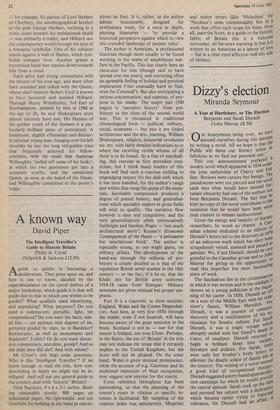A known way
David Piper
The Intelligent Traveller's Guide to Historic Britain Philip A. Crowl (Sidgwick & Jackson £12.95)
Aguide to guides is becoming a desideratum. They press upon us, and how is one to know, dazzled by the superabundance on the travel shelves of a major bookshop, which guide it is that will guide one to that to which one wishes to be guided? What qualities need identifying, and appraising? What purposes? Do you need a vademecum, portable, light, yet compendious?'Do you want the facts, nak- ed lists — yet perhaps with degrees of im- portance graded by stars, as in Baedeker? Restaurants, as well as monuments and Raphaels? Toilets? Or do you want discur- sive commentary, anecdote, gossip? And so she slept here did she? And with whom?
Mr Crowl's title begs some questions. Who is this 'Intelligent Traveller'? If we know enough to read the title, how con- descending to imply we might not be in- telligent. And will not any general guide to the country deal with 'historic' Britain?
Vital Statistics. 9 x 6 x 21/2 inches. Bind- ing reasonably sturdy; 800 pages on substantial paper. No lightweight, and not therefore for holding in the hand as one ex-
plores on foot. It is, rather, as the author admits honourably, designed for preliminary work, for a recce in depth, plotting itineraries — `to provide a historical perspective against which to view this crowded landscape of ancient relics'.
The author is American, a professional historian though more usually to be found working in the realm of amphibious war- fare in the Pacific. This has clearly been an excursion for him (though said to have spread over ten years), and conveying often an agreeable feeling of holiday and personal exploration ('site unusually hard to find, even for Cornwall'). But also anticipating a serious concentration, and stamina, of pur- pose in his reader. The major part (500 pages) is 'narrative history' from pre- history to the close of the second world war. This is recounted in traditional chronological form — political, military, social, economic — but into it are folded architecture and the arts, learning, William Shakespeare, religion, industrial revolution etc. etc. with fairly detailed indications as to where the surviving visible witness of all these is to be found. As a feat of marshall- ing, this exercise at first provoked scep- ticism, but I think many readers of this book will find such a reaction yielding to ungrudging respect for the skill with which it has been handled, for the author's range and within that range his grasp of the essen- tials. Inevitably compression produces a degree of potted history, and generalisa- tions which specialist readers in given fields will wish to qualify. The narrative flow however is easy and compulsive, and the very generalisations often provocatively forthright and fearless. Pugin — 'not much architectural merit'; Keynes's Economic Consequences of the PeaCe — 'a persuasive but mischievous book'. The author is especially strong, as one might guess, on military affairs. The development of the hand-axe through the millenia of pre- history is crisply detailed as is that of the regulation British army musket in the 18th century — or the fact, if it be so, that the Khaki dye for British army uniforms 1914-18 came from Stuttgart. Military museums are given unusual but proper em- phasis.
Part II is a Gazeteer, in three sections: England, Wales and the Crown Dependen- cies. And here, at very first riffle through the reader, even if not Scottish, will have become aware of the great omission in the book. Scotland is not in — nor for that matter is Ireland, not even Ulster. Perhaps, in the States, the use of 'Britain' in the title may not indicate the scope that it certainly implies in the United Kingdom, but the Scots will not be pleased. On the other hand, Wales is given unusual prominence, while the account of e.g. Guernsey and its enshrined memories of Nazi occupation, may suggest new interest for the tourist.
Cross reference throughout has been painstaking, so that the planning of the tourist's route in relation to specific in- terests is facilitated. My sampling of the copious index was satisfactory. Misprints
and minor errors (like 'Nicholson' for `Nicolson') seem commendably few in a work that offers such scope for them. Over all, pace the Scots, as a guide to the historic fabric of Britain this is a welcome newcomer, all the more warming in that it is written by an American as a labour of love — but in a clear-eyed affection well this side of idolatry.






































 Previous page
Previous page